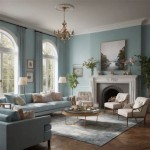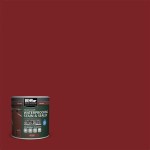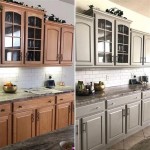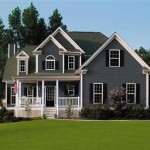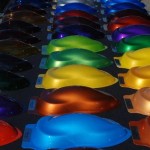What Color to Paint Exterior Pillars: A Comprehensive Guide
Exterior pillars serve as prominent architectural features, contributing significantly to a building's overall aesthetic appeal and structural integrity. Selecting the appropriate paint color for these pillars requires careful consideration of various factors, including the architectural style of the building, the surrounding landscape, and the desired visual impact. A well-chosen color can enhance the pillars' inherent beauty, complement the existing color scheme, and create a cohesive and inviting exterior.
The selection process should extend beyond personal preference, incorporating an understanding of color theory, the effects of sunlight on paint, and the practical implications of maintenance and durability. The goal is to choose a color that not only looks aesthetically pleasing but also withstands the elements and maintains its vibrancy over time. This article provides a comprehensive guide to assist in determining the optimal paint color for exterior pillars.
Understanding the Architectural Style
The architectural style of the building should be the primary determinant in selecting the paint color for exterior pillars. Different architectural styles often adhere to specific color palettes and design principles, and deviating significantly from these can disrupt the building's visual harmony. Ignoring the existing architecture when selecting a color can create a disjointed or incongruous appearance.
For instance, a traditional Colonial-style home often features white or off-white pillars, which evoke a sense of timeless elegance and formality. These shades complement the symmetrical design and classic detailing typically found in Colonial architecture. Using a bold or unconventional color on such pillars could clash with the historical authenticity of the house.
In contrast, a modern or contemporary home may offer greater flexibility in color selection. Neutral shades such as gray, beige, or even darker tones like charcoal can complement the clean lines and minimalist aesthetic often associated with modern architecture. Accents of bolder colors, such as a deep blue or muted green, might also be incorporated to create visual interest, provided they align with the overall design scheme.
Victorian-era homes often feature ornate detailing and intricate trim work. Pillars in this style may benefit from the use of multiple colors to highlight these architectural features. Soft pastels, creams, and off-whites are common choices, with darker accent colors used to accentuate carvings and moldings. Researching historical color palettes appropriate for the specific style of architecture is crucial for maintaining authenticity.
Ranch-style homes typically have a more relaxed and informal aesthetic. Earth tones, such as browns, tans, and muted greens, can complement the low-profile design and blend harmoniously with the surrounding landscape. Lighter shades can also be used to create a brighter and more inviting appearance.
Ultimately, the architectural style serves as a guiding framework for color selection. Consulting with an architect or design professional can provide valuable insights and ensure that the chosen color aligns with the building's overall design intent.
Considering the Surroundings and Landscaping
The surrounding environment and landscaping play a crucial role in determining the appropriate paint color for exterior pillars. The color should complement the natural elements, such as the foliage, the color of the soil, and the overall landscape design. A color that clashes with the surroundings can detract from the building's curb appeal and create a visually jarring effect.
If the building is surrounded by lush greenery, lighter shades, such as white, cream, or light gray, can provide a striking contrast and help the pillars stand out against the backdrop of trees and shrubs. These colors create a clean and fresh appearance and can enhance the building's visibility.
In contrast, if the building is located in a more arid or desert landscape, earth tones, such as browns, tans, and beige, may be more appropriate. These colors blend harmoniously with the natural surroundings and create a sense of warmth and tranquility. The choice between lighter and darker shades within the earth tone spectrum depends on the level of contrast desired.
The color of the building's siding, roofing, and trim also needs to be taken into account. The pillar color should complement these existing elements and contribute to a cohesive and unified aesthetic. Analyzing the existing color palette and identifying colors that harmonize well with it is essential.
Furthermore, the amount of sunlight that the pillars receive can influence the perceived color. In direct sunlight, colors tend to appear brighter and more intense. Darker colors can absorb more heat, which may contribute to premature fading or damage. Lighter colors reflect more sunlight and can help keep the pillars cooler.
Conducting a color test by painting a small section of the pillar and observing it under different lighting conditions can help ensure that the chosen color looks appealing throughout the day. Observing the color at different times of the day and under various weather conditions provide a more accurate representation of its appearance.
Practical Considerations: Durability and Maintenance
Beyond aesthetics, practical considerations such as durability and maintenance should heavily influence the paint color selection for exterior pillars. The chosen paint should be able to withstand the elements, resist fading, and require minimal upkeep. Selecting a high-quality paint specifically formulated for exterior use is essential for ensuring long-lasting protection and preserving the pillars' appearance.
Lighter colors tend to show dirt and stains more readily than darker colors. In areas with high levels of pollution or frequent rainfall, darker shades may be a more practical choice, as they can conceal dirt and grime more effectively. However, darker colors can also absorb more heat, which may lead to premature fading or cracking.
The type of paint finish also plays a crucial role in durability and maintenance. Glossy finishes are easier to clean but can highlight imperfections in the surface. Matte finishes are more forgiving but may be more difficult to clean. Semi-gloss finishes offer a balance between these two extremes and are often a popular choice for exterior trim and pillars.
Selecting a paint with UV resistance is essential for preventing fading and maintaining the color's vibrancy over time. Sunlight can break down the pigments in paint, causing it to lose its color and luster. UV-resistant paints are formulated to withstand the damaging effects of sunlight and maintain their color for longer.
Proper surface preparation is crucial for ensuring that the paint adheres properly and provides long-lasting protection. Before painting, the pillars should be thoroughly cleaned to remove any dirt, grime, or mildew. Any cracks or imperfections should be repaired, and the surface should be primed before applying the topcoat.
Regular maintenance, such as washing the pillars with a mild detergent and water, can help prevent the buildup of dirt and grime and prolong the life of the paint. Inspecting the pillars periodically for any signs of damage, such as cracking or peeling, and addressing these issues promptly can prevent further deterioration.
Ultimately, the selection of paint color should balance aesthetic considerations with practical concerns. Choosing a durable, easy-to-maintain paint color can save time and money in the long run and ensure that the exterior pillars remain attractive and well-protected for years to come. Consulting with a professional painter or paint supplier can provide valuable guidance on selecting the appropriate paint type and finish for specific climate conditions and building materials.
In addition to the above, consideration should be given to the potential impact of the chosen color on the overall energy efficiency of the building. Lighter colors reflect more sunlight and can help keep the building cooler in hot climates, while darker colors absorb more heat and may contribute to increased energy consumption. This is particularly relevant in areas with extreme temperature fluctuations.
The existing hardware and fixtures, such as door handles, light fixtures, and railings, should also be considered when selecting the paint color. The pillar color should complement these elements and contribute to a cohesive and harmonious appearance. Coordinating the color scheme with these existing features enhances visual appeal.
Finally, adherence to any local homeowner association (HOA) regulations or guidelines is paramount. Many HOAs have specific rules regarding exterior colors, and failing to comply with these regulations can result in fines or other penalties. Researching and understanding any applicable HOA restrictions before selecting a paint color is critically important.

40 Glorious Pillar Designs For Your Home

Beautiful Front Door Paint Colors Exterior House

Exterior Colour Consultation In West Vancouver Before After

Interior Paint Color Ideas Exterior Columns Colonial Style House Plans Traditional Porch

50 Inspiring Exterior House Siding Ideas For Your Home Paint Best

Front Porch Columns On Trend Materials Styles Brick Batten

How To Paint Pillars Wikihow
:max_bytes(150000):strip_icc()/front-porch-landscape-ideas-melissa-fitzgerald-west-0822-horiz-eb43a777714e44e49d4bfd868f52167c.jpg?strip=all)
The Best Porch Paint Colors

Love The Door And White Columns House Exterior Dream Colors

How To Box Out Curvy Porch Columns Young House Love
Related Posts


